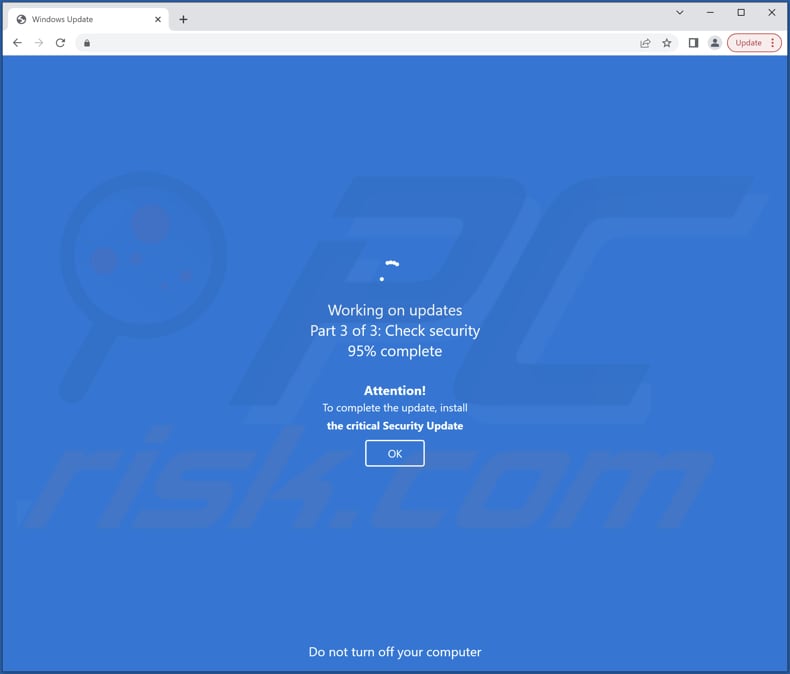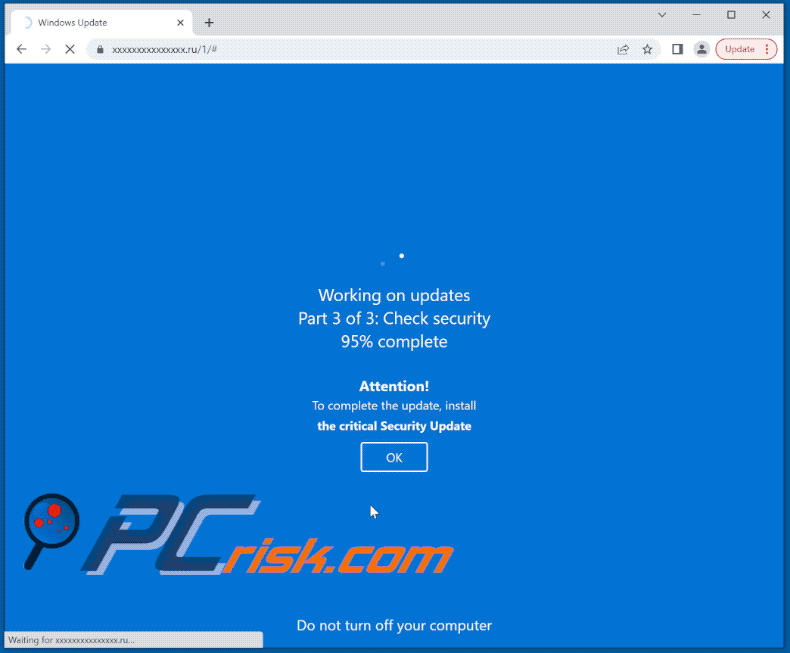How to spot fake messags like "To Complete The Update, Install The Critical Security Update"
Phishing/ScamAlso Known As: To Complete The Update, Install The Critical Security Update scam
Get free scan and check if your device is infected.
Remove it nowTo use full-featured product, you have to purchase a license for Combo Cleaner. Seven days free trial available. Combo Cleaner is owned and operated by RCS LT, the parent company of PCRisk.com.
What is "To Complete The Update, Install The Critical Security Update"?
Upon investigating this website, we found that it is a scam. The purpose of this site is to trick visitors into believing that they must download and install a critical security update. Downloading files from such pages can lead to unwanted installations and computer infections. Thus, it is strongly recommended to ignore messages on websites of this kind.

"To Complete The Update, Install The Critical Security Update" in detail
The message on this page appears to be a fake Windows updating screen designed to trick visitors into downloading something. It claims to be working on updates and shows a circular progress bar. Also, it warns visitors that to complete the update, they must install a critical security update and not turn off their computers.
We found that this page downloads a malicious file named "GoogleUpdate.exe". Scammers behind it probably attempt to deceive users into downloading and installing malicious software (e.g., ransomware). Users should be cautious when encountering such messages and not click on any links or install any software without verifying their authenticity.
It is important to ensure that any software updates or security alerts come from legitimate sources before taking action.
| Name | To Complete The Update, Install The Critical Security Update scam |
| Threat Type | Phishing, Scam, Social Engineering, Fraud |
| Fake Claim | Critical security update is required to complete the update |
| Disguise | Windows update screen |
| Related Domain | xxxxxxxxxxxxxxx[.]ru, loveonehour[.]site, longboothcant[.]site, orcinglemoon[.]site, drowbowal[.]site, rockdeadslow[.]site |
| Detection Names (Domain) | Bfore.Ai PreCrime (Malicious), Combo Cleaner (Malicious), CyRadar (Malicious), G-Data (Malware), malwares.com URL checker (Malicious), Full List Of Detections (VirusTotal) |
| Distributed File | GoogleUpdate.ex |
| Detection Names (File) | Arcabit (Trojan.Agent.GDVM), Combo Cleaner (Trojan.Agent.GDVM), Emsisoft (Trojan.Agent.GDVM (B)), McAfee (Artemis!0A276589BAE0), VIPRE (Trojan.Agent.GDVM), Full List Of Detections (VirusTotal) |
| Symptoms | Fake error messages, fake system warnings, pop-up errors, hoax computer scan. |
| Distribution methods | Compromised websites, rogue online pop-up ads, potentially unwanted applications. |
| Damage | Loss of sensitive private information, monetary loss, identity theft, possible malware infections. |
| Malware Removal (Windows) |
To eliminate possible malware infections, scan your computer with legitimate antivirus software. Our security researchers recommend using Combo Cleaner. Download Combo CleanerTo use full-featured product, you have to purchase a license for Combo Cleaner. 7 days free trial available. Combo Cleaner is owned and operated by RCS LT, the parent company of PCRisk.com. |
Possible damage
Such websites may distribute malicious software, which can infect devices and compromise sensitive information, such as personal and financial data. The malware can also be designed to damage or encrypt users' files, mine cryptocurrency, provide cybercriminals with remote access to infected computers, and more.
A couple examples of scams similar to the one described in this article are "Critical Threat Detected: Adware App", "Admittance To This PC Has Been Hindered", and "Windows Firewall Protection Alert".
How did I open a scam website
There are several ways that users can end up on scam websites. One common way is through phishing emails or fake social media messages that trick users into clicking on a malicious link. Another way is through online ads that lead users to fake websites that mimic legitimate ones.
Users can also be directed to scam websites through search engine results that have been manipulated by scammers using SEO techniques. Additionally, some scam websites use typosquatting, which involves creating domain names similar to popular websites but with minor spelling errors.
How to avoid visiting scam pages?
Always be cautious when clicking on links in emails or social media messages, and only click on links from trusted sources. Be wary of online ads, and avoid clicking on ads that seem suspicious or lead to unfamiliar websites. Use anti-virus and anti-malware software to help protect devices from malicious software.
Dot agree to receive notifications from shady websites. If your computer is already infected with unwanted apps, we recommend running a scan with Combo Cleaner Antivirus for Windows to automatically eliminate them.
The appearance of "To Complete The Update, Install The Critical Security Update" pop-up scam (GIF):

Text in this scam:
Working on updates
Part 3 of 3: Check security
95% completeAttention!
To complete the update, install the critical Security Update
[OK]
Do not turn off your computer
Instant automatic malware removal:
Manual threat removal might be a lengthy and complicated process that requires advanced IT skills. Combo Cleaner is a professional automatic malware removal tool that is recommended to get rid of malware. Download it by clicking the button below:
DOWNLOAD Combo CleanerBy downloading any software listed on this website you agree to our Privacy Policy and Terms of Use. To use full-featured product, you have to purchase a license for Combo Cleaner. 7 days free trial available. Combo Cleaner is owned and operated by RCS LT, the parent company of PCRisk.com.
Quick menu:
- What is To Complete The Update, Install The Critical Security Update scam?
- How to identify a pop-up scam?
- How do pop-up scams work?
- How to remove fake pop-ups?
- How to prevent fake pop-ups?
- What to do if you fell for a pop-up scam?
How to identify a pop-up scam?
Pop-up windows with various fake messages are a common type of lures cybercriminals use. They collect sensitive personal data, trick Internet users into calling fake tech support numbers, subscribe to useless online services, invest in shady cryptocurrency schemes, etc.
While in the majority of cases these pop-ups don't infect users' devices with malware, they can cause direct monetary loss or could result in identity theft.
Cybercriminals strive to create their rogue pop-up windows to look trustworthy, however, scams typically have the following characteristics:
- Spelling mistakes and non-professional images - Closely inspect the information displayed in a pop-up. Spelling mistakes and unprofessional images could be a sign of a scam.
- Sense of urgency - Countdown timer with a couple of minutes on it, asking you to enter your personal information or subscribe to some online service.
- Statements that you won something - If you haven't participated in a lottery, online competition, etc., and you see a pop-up window stating that you won.
- Computer or mobile device scan - A pop-up window that scans your device and informs of detected issues - is undoubtedly a scam; webpages cannot perform such actions.
- Exclusivity - Pop-up windows stating that only you are given secret access to a financial scheme that can quickly make you rich.
Example of a pop-up scam:

How do pop-up scams work?
Cybercriminals and deceptive marketers usually use various advertising networks, search engine poisoning techniques, and shady websites to generate traffic to their pop-ups. Users land on their online lures after clicking on fake download buttons, using a torrent website, or simply clicking on an Internet search engine result.
Based on users' location and device information, they are presented with a scam pop-up. Lures presented in such pop-ups range from get-rich-quick schemes to fake virus scans.
How to remove fake pop-ups?
In most cases, pop-up scams do not infect users' devices with malware. If you encountered a scam pop-up, simply closing it should be enough. In some cases scam, pop-ups may be hard to close; in such cases - close your Internet browser and restart it.
In extremely rare cases, you might need to reset your Internet browser. For this, use our instructions explaining how to reset Internet browser settings.
How to prevent fake pop-ups?
To prevent seeing pop-up scams, you should visit only reputable websites. Torrent, Crack, free online movie streaming, YouTube video download, and other websites of similar reputation commonly redirect Internet users to pop-up scams.
To minimize the risk of encountering pop-up scams, you should keep your Internet browsers up-to-date and use reputable anti-malware application. For this purpose, we recommend Combo Cleaner Antivirus for Windows.
What to do if you fell for a pop-up scam?
This depends on the type of scam that you fell for. Most commonly, pop-up scams try to trick users into sending money, giving away personal information, or giving access to one's device.
- If you sent money to scammers: You should contact your financial institution and explain that you were scammed. If informed promptly, there's a chance to get your money back.
- If you gave away your personal information: You should change your passwords and enable two-factor authentication in all online services that you use. Visit Federal Trade Commission to report identity theft and get personalized recovery steps.
- If you let scammers connect to your device: You should scan your computer with reputable anti-malware (we recommend Combo Cleaner Antivirus for Windows) - cyber criminals could have planted trojans, keyloggers, and other malware, don't use your computer until removing possible threats.
- Help other Internet users: report Internet scams to Federal Trade Commission.
Frequently Asked Questions (FAQ)
What is a pop-up scam?
A pop-up scam refers to a form of Internet scamming where pop-up windows appear on the user's screen while browsing the Internet, mimicking legitimate alerts or error messages from the user's computer or a trusted website. The intention is to deceive the user into taking action that benefits the scammer.
What is the purpose of a pop-up scam?
The purpose of a pop-up scam is to deceive and trick users into providing personal information, downloading malware or malicious software, purchasing fake or counterfeit goods, or subscribing to unwanted services.
Why do I encounter fake pop-ups?
Pop-up scams are typically disseminated through malevolent websites, and users are often not intentionally navigating to these sites. Rather, users are redirected to these sites by either malicious applications installed on their devices or by visiting a website that utilizes a dubious advertising network.
Will Combo Cleaner protect me from pop-up scams?
Combo Cleaner can scan websites and can identify those that are malevolent. This includes websites that are created to distribute pop-up scams, and if such a site is detected, Combo Cleaner will promptly show a warning and restrict access to the site.
Share:

Tomas Meskauskas
Expert security researcher, professional malware analyst
I am passionate about computer security and technology. I have an experience of over 10 years working in various companies related to computer technical issue solving and Internet security. I have been working as an author and editor for pcrisk.com since 2010. Follow me on Twitter and LinkedIn to stay informed about the latest online security threats.
PCrisk security portal is brought by a company RCS LT.
Joined forces of security researchers help educate computer users about the latest online security threats. More information about the company RCS LT.
Our malware removal guides are free. However, if you want to support us you can send us a donation.
DonatePCrisk security portal is brought by a company RCS LT.
Joined forces of security researchers help educate computer users about the latest online security threats. More information about the company RCS LT.
Our malware removal guides are free. However, if you want to support us you can send us a donation.
Donate
▼ Show Discussion